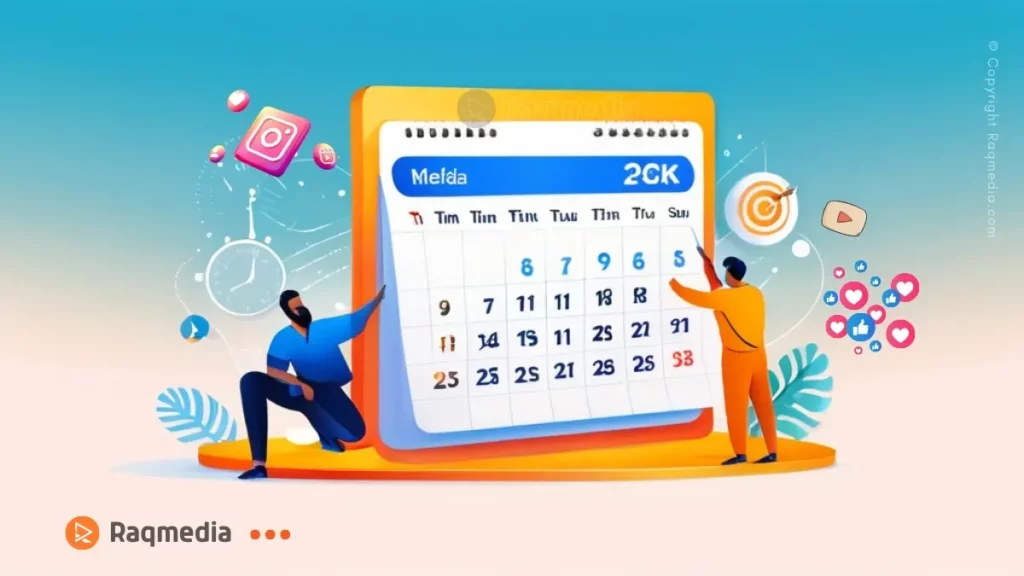In the intricate web of social media, where digital footprints form the crux of brand visibility, consistency reigns supreme. Picture this: a symphony of strategic posts orchestrated in harmony with an unwavering rhythm – that's the artful cadence we aim to unravel within the realm of social media. Establishing and maintaining a consistent posting schedule is not mere conjecture; it is the pulse that drives brand presence forward, captivating audiences with an allure both subtle and powerful.
Creating Consistent Posting Rhythms on Social Media
Peek behind the curtain of algorithms dictating our digital landscapes, and you'll discover their affinity for dependable cadence. These complex mechanisms favor content creators who march to the beat of consistency, rewarding them with higher visibility amidst the buzzing feed. An unswerving posting pattern isn't just a tactic; it forms the cornerstone upon which engagement levels flourish, sparking connections that transcend fleeting scrolls into enduring relationships forged through loyalty.

Join us on this enlightening journey as we dig into the art of cadence, creating consistent posting rhythms on social media, where success finds its footing in rhythmic reliability and brand devotion blooms in the fertile soil of steadfastness.
Understanding Social Media Algorithms
Social media algorithms are automated systems implemented by platforms like Facebook, Instagram, and Twitter to analyze user behavior and display content that is most likely to be engaging for individual users. These algorithms continuously evolve based on user interactions and feedback, aiming to enhance the overall user experience by showing relevant and compelling content. Understanding how social media algorithms function is crucial for marketers looking to optimize their reach and engagement levels.
Algorithms play a pivotal role in determining which posts appear on users' feeds. By favoring content that demonstrates consistency in posting schedules and aligns with users' interests, social media algorithms help amplify the visibility of brands. For instance, if a business regularly shares valuable content at specific times when its target audience is most active online, algorithms are more likely to prioritize showcasing these posts to a larger audience. This emphasis on consistency underscores the importance of maintaining a steady cadence in posting to stay relevant within algorithmic calculations.
Consistent posting not only enhances algorithmic visibility but also reinforces brand credibility among followers. When users repeatedly see content from a brand at regular intervals, it establishes trust and familiarity. Moreover, frequent postings signal to the algorithms that the brand is active and engaged with its audience, boosting the likelihood of appearing prominently in users' feeds. In essence, mastering consistent posting patterns acts as a catalyst for improved algorithmic performance and sustained audience engagement over time.
Setting Posting Goals and Objectives
In the realm of social media management, setting clear posting goals and objectives serves as the compass guiding brands towards their desired outcomes. These goals should closely align with overarching marketing strategies to ensure that every post contributes to the larger narrative crafted by the brand. For instance, a goal could be to increase brand awareness through consistent posting of informative content that resonates with the audience's interests. By defining specific goals like these, social media managers can focus their efforts effectively.
Identifying key performance indicators (KPIs) plays a pivotal role in evaluating the success and impact of social media posts. These KPIs could vary from platform reach and engagement rates to website traffic generated from social media channels. For example, a KPI for an e-commerce business might be tracking conversion rates resulting from social media campaigns to measure the direct return on investment in terms of sales generated by each post. Selecting relevant KPIs enables businesses to gauge the effectiveness of their posting strategies quantitatively.
Tailoring objectives based on platform-specific features and understanding audience behavior are essential components of crafting successful social media posts. Different platforms have unique functionalities and user demographics that influence how content is consumed and engaged with. For instance, Instagram's visual-centric nature might require a focus on compelling visuals or videos, while Twitter's character limit demands concise yet impactful messaging. By adapting content strategies to resonate with each platform's nuances, brands can maximize their reach and engagement potential effectively.
By strategically defining goals, selecting appropriate KPIs, and customizing objectives based on platforms and audiences, brands can elevate their social media presence with purpose-driven posting rhythms. This intentional approach not only enhances brand visibility but also establishes meaningful connections with followers, ultimately driving towards achieving broader marketing goals in a digital landscape where consistency is key to lasting success.
Creating a Content Calendar
In the realm of social media management, a content calendar serves as the compass guiding consistent posting rhythms for brands and businesses. Defined as a scheduled timeline outlining when and what content will be posted across various platforms, a content calendar is the cornerstone of maintaining relevance and engaging audiences effectively. Through strategic planning and foresight, content calendars enable marketers to stay organized, aligning posts with overarching objectives while preventing erratic or haphazard publishing practices.
When crafting a comprehensive content calendar, meticulous attention must be paid to frequency and timing considerations. For instance, if your target audience primarily engages with Instagram during evening hours, scheduling posts accordingly can significantly impact visibility and engagement rates. By analyzing platform insights and understanding audience behaviors, you can optimize scheduling to reach users when they are most active. Moreover, incorporating themes, industry events, or trending topics into the content calendar adds diversity and captivates followers with relevant and timely content.
Imagine a cosmetics brand mapping out their content calendar for the month of October. They could strategically plan Halloween-themed makeup tutorials or product launches to coincide with the festive season, leveraging trending topics to garner attention and participation from their audience. This approach not only maintains consistency but also demonstrates an understanding of consumer interests while keeping the brand at the forefront of industry conversations. In essence, a well-crafted content calendar acts as a roadmap for navigating the dynamic landscape of social media posting, ensuring that each post contributes meaningfully towards overarching goals and resonates with the intended audience.
Optimizing Content for Different Platforms
When it comes to social media, a one-size-fits-all approach rarely yields optimal results. Each platform possesses unique characteristics, user behavior trends, and content formats that demand tailored strategies for maximum impact. Adapting content for various social media platforms is crucial in reaching diverse audiences effectively. For instance, Instagram thrives on visually appealing images and videos, making it ideal for showcasing products or lifestyle content through high-quality visuals. In contrast, Twitter's concise nature emphasizes punchy messages and timely updates suitable for news dissemination or quick engagement with followers.
To achieve success across different platforms, understanding and implementing platform-specific best practices are paramount. For example, utilizing hashtags strategically on Twitter can increase discoverability and engagement by joining trending conversations or categorizing content. On LinkedIn, focusing on professional insights, industry news, and thought leadership articles resonates well with its business-oriented audience. Moreover, adapting the tone and style of posts while maintaining a consistent brand voice ensures a cohesive brand identity across all platforms. This harmonious blend of customization and branding helps foster trust and recognition among followers.

Maintaining brand voice integrity while customizing content involves striking a delicate balance between consistency and platform relevance. For instance, a fashion brand may maintain its chic aesthetic on Instagram while tailoring its messaging to align with LinkedIn's professional environment by sharing behind-the-scenes glimpses into the industry. By understanding the nuances of each platform and adhering to best practices specific to them, businesses can amplify their outreach efforts significantly while nurturing authentic connections with their audience members.
Leveraging Scheduling Tools for Efficient Posting
In the realm of social media management, leveraging scheduling tools can be a game-changer when it comes to maintaining consistent posting rhythms. These tools offer convenience and efficiency by allowing users to plan and automate their content distribution across various platforms. For instance, platforms like Buffer, Hootsuite, or Sprout Social provide scheduling features that enable users to queue up posts in advance based on their editorial calendar. By utilizing these tools, social media managers can ensure a steady flow of content without having to manually post each update.
When comparing different scheduling tools available in the market, it is essential to consider factors such as platform compatibility, user interface intuitiveness, analytics integration, and cost-effectiveness. For example, while Buffer is known for its simplicity and robust analytics reporting, Hootsuite's strength lies in its versatility with a wide range of integrations and monitoring capabilities across multiple social networks. Choosing the right tool that aligns with specific posting needs and budget constraints is crucial for maximizing efficiency.
Setting up schedules efficiently using these tools involves strategic planning and organization. Social media managers should create a content calendar outlining post frequency, timings for optimal audience reach, and variations in content types. By establishing a well-structured schedule within the chosen scheduling tool, individuals can streamline their posting process and maintain a consistent cadence effortlessly. Additionally, setting reminders or notifications within these tools can help keep track of upcoming posts and ensure timely execution of the planned content strategy.
Monitoring Performance Metrics
In the realm of social media management, monitoring performance metrics is akin to having a compass that guides your posting strategies towards success. Key performance indicators (KPIs) serve as the North Star, illuminating the path to understanding how well your content resonates with your audience. Essential metrics include but are not limited to reach, engagement rate, click-through rate, and conversion rates. For instance, tracking engagement levels through metrics like likes, shares, and comments can provide insights into audience preferences and sentiments.
Data insights derived from analytics tools act as a treasure trove of information for refining your posting strategies. By delving into these analytics, you can uncover trends regarding when your audience is most active or which type of content garners the most traction. For example, if analytics reveal that a particular post format generates higher engagement rates than others, doubling down on that format can be a strategic move to boost overall performance.
Fine-tuning posting patterns based on thorough performance analysis is crucial for continuous improvement. Suppose data indicates that posts published at certain times receive more interactions. In that case, adjusting your scheduling tool to accommodate those peak hours could significantly enhance engagement levels. Through this iterative process of analyzing data and tweaking strategies accordingly, you can cultivate a social media presence that resonates with your audience authentically and consistently over time.
By embracing the practice of monitoring performance metrics rigorously and using data-driven insights to inform decision-making processes, you pave the way for sustained growth and relevance in the dynamic landscape of social media marketing. Remember, each metric tells a story about how your content performs and provides valuable clues on how best to optimize future posts for maximum impact.
Engaging with followers proactively plays a pivotal role in maintaining a vibrant and interactive social media presence. Responding to comments, messages, and polls promptly showcases a brand's commitment to foster genuine connections with its audience. By actively engaging with followers, businesses can humanize their online persona and build trust among their community. For instance, responding to customer inquiries in a timely manner not only resolves issues efficiently but also demonstrates attentive customer service, strengthening brand loyalty.
Developing strategic initiatives to stimulate user interaction is essential for sustaining a dynamic online environment. Encouraging followers to participate in contests, surveys, or interactive posts can captivate their interest and prompt them to engage more frequently. For example, hosting Q&A sessions or live streams where followers can directly interact with the brand creates a sense of exclusivity and enhances the overall user experience. By creating opportunities for dialogue and feedback, businesses can gather valuable insights that inform future content strategies tailored to meet audience preferences.
Fostering a sense of community through authentic interactions is key to building lasting relationships with followers. Sharing user-generated content, acknowledging loyal customers publicly, or featuring fan testimonials can amplify engagement levels and nurture a sense of belonging within the community. Brands like Glossier excel at cultivating a strong bond with their customers by reposting user-submitted photos on social media platforms, celebrating diversity and inclusivity while encouraging active participation from their audience. Authenticity in responses and actions fosters an emotional connection that goes beyond mere transactions, establishing a loyal following invested in the brand's journey.
In conclusion, proactive engagement with followers elevates social media strategies by nurturing meaningful interactions that go beyond superficial metrics. By valuing each interaction as an opportunity to connect on a personal level, brands can create an inclusive digital ecosystem where followers feel valued and heard. Establishing a two-way communication channel cultivates brand advocacy and paves the way for sustained growth through genuine relationships built on trust and mutual respect.
Evaluating The Success of Social Media
Evaluating the success of social media posting strategies is fundamental to refining and optimizing future content plans. By defining clear success criteria aligned with predetermined goals and key performance indicators (KPIs), marketers can objectively measure the impact of their consistent posting efforts. For instance, if a brand's goal is to increase website traffic through social media, relevant KPIs could include click-through rates from posts or the number of visits generated by social media referrals.
Regular evaluations play a pivotal role in this process, allowing for a systematic review of how well the established goals are being met. Analyzing metrics like engagement rates, follower growth, and conversions provides valuable insights into the effectiveness of current posting patterns. For example, frequent monitoring may reveal that certain post formats—such as videos or infographics—resonate better with the audience, prompting a shift towards creating more of such content for enhanced engagement.
Furthermore, incorporating feedback derived from analytics reports is crucial in iteratively improving social media strategies. For instance, if data indicates that posts published on weekends receive significantly higher engagement than weekday posts, adjusting the posting schedule accordingly can lead to improved outcomes. This iterative approach based on data-driven insights not only ensures relevance and efficiency but also demonstrates a commitment to continuous enhancement and adaptation in response to evolving audience preferences.
In short, evaluating success and iterating strategies based on performance analysis are indispensable components of mastering consistent social media posting rhythms. Through diligent assessment, strategic adjustments imbued with audience-centric insights, brands can refine their approaches for sustainable growth and increased impact in the ever-evolving landscape of social media marketing.
Sustaining Consistency for Long-Term Growth
Consistency in social media posting is not merely a short-term strategy but a cornerstone for long-term brand growth and success. By mastering the cadence of your content delivery, you pave the way for sustained engagement and audience loyalty. The ability to adapt and refine your posting strategies in response to performance metrics and evolving trends is key to staying relevant amidst the ever-changing social media landscape. As platforms shift algorithms and user behaviors evolve, maintaining a consistent presence with tailored content remains paramount.
In summary, sustaining consistency in your social media posting patterns requires a strategic approach grounded in data-driven insights. Reflect on the importance of setting specific goals aligned with your overall marketing objectives. Regular evaluations of your posting performance will provide invaluable feedback to shape future strategies effectively. Remember that consistency does not equate to monotony; it involves a dynamic interplay between planned content themes and spontaneous interactions that resonate with your audience.
To ensure long-term growth through consistent posting, continue refining your strategies based on a deep understanding of your audience preferences and platform nuances. Embrace flexibility while adhering to an overarching posting schedule to foster reliability among followers. By leveraging analytics tools for actionable insights and actively engaging with your community, you fortify relationships that are essential for sustained success in the competitive social media realm. Cultivate authenticity in every interaction to solidify trust and instill brand loyalty among your followers.
Final Tips for Mastering Consistent Social Media Posting Patterns
Leverage Automation Wisely
Utilize scheduling tools to automate your posting schedule, but ensure that you balance automation with real-time engagement. For example, while a tool like Hootsuite can help streamline posts across platforms, remember to personally respond to comments or messages promptly to maintain an authentic connection with your audience.
Embrace A/B Testing
Experiment with different posting frequencies, content types, and posting times to identify what works best for your specific target audience. For instance, try posting at varied times during the day or week and analyze the performance metrics to understand when your audience is most active and receptive to your content.
Stay Agile in Content Strategy
Keep an eye on emerging trends and adjust your content strategy accordingly. For example, if a new feature rolls out on a social media platform that aligns well with your brand's messaging, incorporate it into your content calendar promptly to stay relevant and engaging. Adapting quickly to changes demonstrates flexibility and keeps your audience engaged with fresh and innovative content.

By following these final tips in conjunction with the comprehensive strategies outlined earlier in this article, you can elevate your social media presence by mastering consistent posting patterns. Remember that sustained efforts towards consistency yield long-term benefits in brand visibility, engagement levels, and ultimately, business growth. Continuously refine your approach based on analytics insights, user feedback, and industry trends to position yourself as a dynamic force on social media platforms.
Sustaining Consistency for Long-Term Growth
Consistency in social media posting is the backbone of a successful digital presence. By establishing and maintaining a regular posting schedule, businesses can enhance their visibility, engagement levels, and ultimately cultivate a loyal following. The strategic approach detailed throughout this guide provides marketers, social media managers, business owners, and content creators with the necessary tools to navigate the intricate landscape of social media algorithms, content planning, platform optimization, and performance tracking. Mastering consistent social media posting patterns is not just about frequency; it's about delivering value to your audience consistently over time.
As you embark on implementing your newfound knowledge into your social media strategies, remember that sustained efforts yield long-term results. Regularly evaluate your performance metrics, engage proactively with your followers, seek continuous improvement through data-driven insights, and adapt to evolving trends. Success in the realm of social media requires dedication to honing your craft and refining your tactics based on feedback and analytics. By striving for consistency while remaining agile in response to change, you can position your brand for lasting success in the dynamic world of digital marketing.
FAQs:
Q: How frequently should I post on social media platforms?
A: The ideal posting frequency varies based on platform and audience preferences; however, aiming for a consistent schedule (e.g., once a day or several times per week) is recommended.
Q: What are some common mistakes to avoid when creating a content calendar?
A: Avoid over-scheduling posts without considering audience engagement patterns or neglecting to incorporate current trends or events that may impact content relevance.
Q: Do all social media platforms require the same level of consistency in posting?
A: While consistency is crucial across all platforms, different platforms may have varying optimal frequencies and content types based on user expectations.
Q: How important is it to respond to every comment or message from followers?
A: Engagement with followers fosters relationships and builds community trust; aim to respond promptly and authentically while prioritizing meaningful interactions.
Q: Can I reuse the same content across multiple platforms during my posting schedule?
A: While repurposing content can save time, ensure that it aligns with each platform's unique requirements and audience preferences for maximum effectiveness.










📢 Unlock the secrets to mastering social media posting rhythms with RaqMedia! Elevate your online presence with expert tips and strategies. 💡 Follow us for more insights and give us a thumbs up! 👍 Dive into the article here:
The Art Of Cadence: Creating Consistent Posting Rhythms On Social Media
https://www.raqmedia.com/creating-consistent-posting-rhythms-on-social-media/
#raqmedia #socialmedia #posting #strategy #digitalmarketing #branding #engagement #contentstrategy